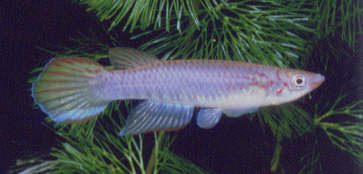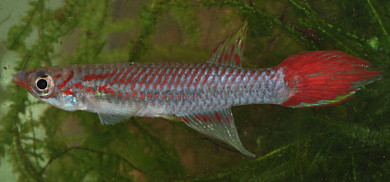Epiplatys njalaensis Neumann 1976

Wild male collected at Munguna
in the Rinka River, Sierra Leone.
Photo courtesy of Ed Pürzl.
| Meaning of Name |
After the area they were caught from - Njala. |
||
| First Description |
Neumann W. 1976 |
||
| Size |
Standard length is given as 6 cm by Romand (1992). |
||
| Meristics |
|
||
| Karyotype |
|
||
| Sub-Genus |
Epiplatys |
||
| Group |
fasciolatus |
||
| Synonyms |
|
||
Populations
|
Vaama - Collected by Fred Wright, Rod Roberts & John Parker et al half a mile from the village of Vaama & inhabited a stream which flowed under the road in a well shaded pool further inland from the road. This pool formed by the stream was 10 feet wide & about 10" deep at the deepest part. Also found in this pool were E.fasciolatus. Two populations were found (Vaama & Mayepema). Vaama was the least colourful of the two. Water temperature 78°F, pH 6·3, DH 2. Mayepema - Collected by Fred Wright, Rod
Roberts & John Parker et al near to Mayepema village in a 'small
pool formed in a slightly flowing stream'. Many pools were observed
in this stream varying from 10-18" deep & 3-10 feet wide. Water
temperature 77°F, pH 6·3, DH 2.
|
||
| Type Locality |
Njala, Southwest Province, approximately 4 miles north of Mano Geleben, Yong River drainage. |
||
| Distribution |
Fairly restricted to the area of the type locality. http://homepage.uibk.ac.at/homepage/c102/c102mr/epiplaty/njalaens.htm |
||
| Habitat |
Rainforest streams & creeks. |
||
| Distinguishing Characteristics | A full description of the Vaama & Mayepema populations can be found in BKA newsletter No.131, July 1976. | ||
| Colour/Pattern Variability | Low | ||
| History |
Discovered by Roloff in 1975 near the village of Njala, Southwest Province, Sierra Leone. Also collected by Fred Wright, Rod Roberts & John Parker et al in the early part of 1976 in 2 localities which differed in the intensity of colour. |
||
| Breeding Notes |
Regarded as a difficult species to breed. Their is little information on breeding habits available except that young grow slowly reaching sexual maturity at about 7-8 months. The Mayepema & Vaama populations were bred
in the UK in 1976 & found prolific with periodic lay offs from spawning.
Eggs were deposited in floating mops & were taken out & incubated
in smaller containers with water from the parents tank. Water incubation
was observed as being rapid with fry emerging after only 10 days. It
was noted that the newly hatched fry require plenty of space. The fry
were observed to stay to the sides of the hatching container in a head
down position. |
||
| Diameter of Egg | |||
| Remarks |
|
